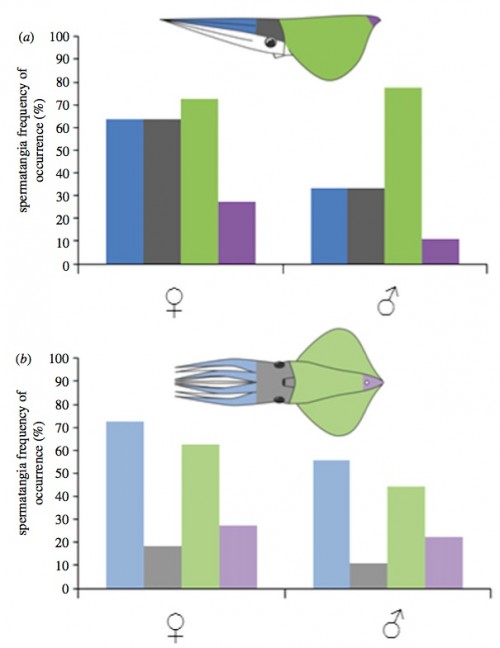Some species of cephalopods are incapable of concealing their sexual history. The males produce packets of sperm called spermatangia that they grasp with a specialized arm that they then reach out and splat, poke into their mate. In Octopoteuthis deletron, a deep-sea squid, these spermatangia are large, pale, and distinctive, so every time a squid is mated it’s left with a little white dangling flag marking it — so sex is like a combination of tag and paintball. The males are loaded with ammo — 1646 were counted in the reproductive tract of one male — and the spermatangia can be counted using a video camera.
So a ROV went down deep into the Monterey Submarine Canyon and documented the profligate promiscuity of these squid. The females had been busy: individuals had between 21 and 147 spermatangia dangling from them.

(a) A female Octopoteuthis deletron showing implanted spermatangia in the ventral arms, the ventral lateral mantle and the ventral mid and posterior mantle (arrows) and the characteristic rugose skin of the anterior mantle in females. (b) A spermatangium showing the bulbous proximal portion containing sperm, and the trailing open end. (c) A male O. deletron with implanted spermatangia on the dorsal mantle; the trailing ends are visible in profile. (d) Close-up of (c).
The surprise was that the males were equally likely to have been inseminated multiple times in their life, between 15 and 25 times. They’re all manic bisexuals! They’re also creative in their sexual behavior; as you can see below, spermatangia are implanted everywhere, mantle, arms, ventrally, dorsally. It’s all one big gay orgy down there under the sea.

Frequency of occurrence of spermatangia present on the (a) dorsal and (b) ventral body of male and female O. deletron. The colours of the body parts correspond with the colours of the bars in the graph.
Most cephalopods, this species included, live short lives and the perpetuation of the species relies on rapid, successful mating. The authors explain this same-sex mating behavior as an adaptive response to a life-style in which discrimination is less important than simply getting the job done.
We have only observed them as solitary individuals. The combination of a solitary life, poor sex differentiation, the difficulty of locating a conspecific and the rapidity of the sexual encounter probably results in the observed high frequency of spermatangia-bearing males in this species. Apparently, the costs involved in losing sperm to another male are smaller than the costs of developing sex discrimination and courtship, or of not mating at all. This behaviour further exemplifies the ‘live fast and die young’ life strategy of many cephalopods.
I prefer to think of it as a brief happy life spent writhing constantly, passionately in the arms of love.
Hoving HJT, Bush SL, Robison BH (2011) A shot in the dark: same-sex sexual behaviour in a deep-sea squid. Biol. Lett. doi:10.1098/rsbl.2011.0680.
(Also on Sb)


Somewhere in America, Maggie Gallagher (of NOM fame) has just lost her liking for calamari
Whoa.
Who knew Brownian was secretly a squid?
Apparently they have their own version of the near-death experience.
It’s quantum mental gymnastics written in spermatangia form…
Glen Davidson
The squid can’t tell boy-squid from girl-squid!?‽?
Maybe they can. They just don’t care.
If they could, wouldn’t they? The hypothesis that sperm is cheaper than discrimination sounds more likely to me.
The Creator was a total dumb-ass.
or a really Fun Guy.
Why does the mantle seem to be so preferred on boy-squid? Is it just bigger, or is it like squid-anal?
It’s not an orgy, it’s a crap-shoot!
This explains the two male squid of different species caught “tagging” each other.
Sounds like a lonely life with only the occasional potential mate heaving into view.
“You said you were working late! Why are there new spermatangia on your collar?”
Sili:
From the paper:
It would seem that the question is the other way around: Why are females implanted more often in the tentacles?
For some reason, now I have this song running though my head…
Along those lines, one of the most vile parasites, Cimex lectularius (common bed bug) mates violently in a form of stabby-rape:
Too bad they can’t all die in a fire.
Usernames are stupid
grow up
PZ, this might be why some people keep sending you gay porn. The question is whether it is intended as a deliberate insult, or just squid-envy.
I like this… but “perpetuation of the species” strikes me as a pretty unfortunate turn of phrase. Wouldn’t it be better to say that this strategy offers the best chance for individuals to leave descendants in the circumstances? Even then that’s not quite right, but a truly gene’s-eye formulation might be a bit lengthy. The “survival of the species” meme really raises my hackles; it leads to so many misunderstandings.
Squid don’t have any ancient book of superstitions to tell them to stone those who don’t conform.
So how often do spermatangia get implanted someplace where they might actually fertilize an egg?
How many partners does each squid have? (I’m thinking of my neighbor’s cat, with her most recent litter of multiple colors, head shapes and coat lengths.)